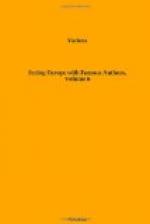Straddling the Rhone, where it issues from the bluest lake in the world, looking out upon green meadows and wooded hills, backed by the dark ridge of the Saleve, with the “great white mountain” visible in the distance, Geneva has the advantage of an incomparable site; and it is, from a town surveyor’s point of view, well built. It has wide thoroughfares, quays, and bridges; gorgeous public monuments and well-kept public gardens; handsome theaters and museums; long rows of palatial hotels; flourishing suburbs; two railway-stations, and a casino. But all this is merely the facade—all of it quite modern; hardly any of it more than half a century old. The real historical Geneva—the little of it that remains—is hidden away in the background, where not every tourist troubles to look for it. It is disappearing fast. Italian stonemasons are constantly engaged in driving lines through it. They have rebuilt, for instance, the old Corraterie, which is now the Regent Street of Geneva, famous for its confectioners’ and booksellers’ shops; they have destroyed, and are still destroying, other ancient slums, setting up white buildings of uniform ugliness in place of the picturesque but insanitary dwellings of the past. It is, no doubt, a very necessary reform, tho’ one may think that it is being executed in too utilitarian a spirit. The old Geneva was malodorous, and its death-rate was high. They had more than one Great Plague there, and their Great Fires have always left some of the worst of their slums untouched. These could not be allowed to stand in an age which studies the science and practises the art of hygiene. Yet the traveler who wants to know what the old Geneva was really like must spend a morning or two rambling among them before they are pulled down.
The old Geneva, like Jerusalem, was set upon a hill, and it is toward the top of the hill that the few buildings of historical interest are to be found. There is the cathedral—a striking object from a distance, tho’ the interior is hideously bare. There is the Town Hall, in which, for the convenience of notables carried in litters, the upper stories were reached by an inclined plane instead of a staircase. There is Calvin’s old Academy, bearing more than a slight resemblance to certain of the smaller colleges at Oxford and Cambridge. There, too, are to be seen a few mural tablets, indicating the residences of past celebrities. In such a house Rousseau was born; in such another house or in an older house, now demolished, on the same site—Calvin died. And toward these central points the steep and narrow, mean streets—in many cases streets of stairs—converge.
As one plunges into these streets one seems to pass back from the twentieth century to the fifteenth, and need not exercise one’s imagination very severely in order to picture the town as it appeared in the old days before the Reformation. The present writer may claim permission to borrow his own description from the pages of “Lake Geneva and its Literary Landmarks:”




